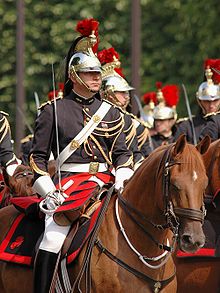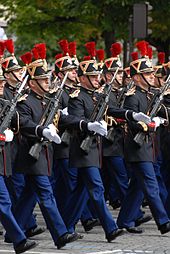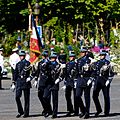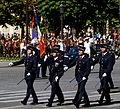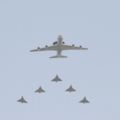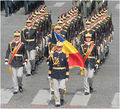- Bastille Day Military Parade
-
The Bastille Day Military Parade (or 14 July Military Parade, translation of the French name of Défilé militaire du 14 Juillet) is a French military parade that has been held on the morning of 14 July each year in Paris since 1880, almost without exception.
The parade passes down the Champs-Elysées from l’Arc de Triomphe to Place de la Concorde where the President of the French Republic, his government and foreign ambassadors to France stand. This is a popular event in France, broadcast on French TV, and is the oldest and largest regular military parade in the world. In some years, invited detachments of foreign troops take part in the parade and foreign statesmen attend as guests.
Smaller military parades are held in French garrison towns (like Toulon or Belfort) with local troops.
Contents
Organization
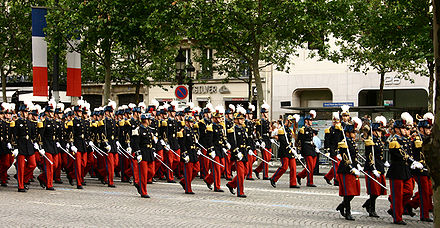 Saint-Cyr cadets parading on the 14 July 2007
Saint-Cyr cadets parading on the 14 July 2007
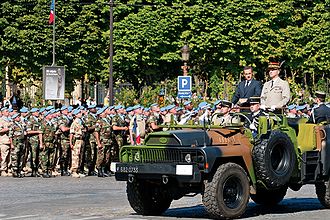 Nicolas Sarkozy, President of the French Republic and General Jean-Louis Georgelin, Chief of the Defence Staff reviewing the troops in an ACMAT command car.
Nicolas Sarkozy, President of the French Republic and General Jean-Louis Georgelin, Chief of the Defence Staff reviewing the troops in an ACMAT command car.
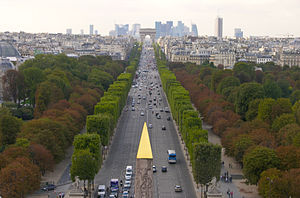 The Military Parade occurs on the Champs-Élysées Avenue, from the Arc de Triomphe to the Place de la Concorde, where French officials and foreign guests view the ceremony.
The Military Parade occurs on the Champs-Élysées Avenue, from the Arc de Triomphe to the Place de la Concorde, where French officials and foreign guests view the ceremony.
The parade opens with cadets from the military schools in order of seniority: the École Polytechnique, the Saint-Cyr, the École Navale, followed by newer academies. The Patrouille de France leads the fly-past.
Recently, it has become customary to invite units from France’s close allies to participate in the parade. For instance, in 2004, to mark the centenary of the Entente Cordiale, British troops (the band of the Royal Marines, the Household Cavalry Mounted Regiment, Grenadier Guards and King's Troop, Royal Horse Artillery) led the Bastille Day parade in Paris, with the Red Arrows flying overhead. While British troops had participated in the Bastille Day parades of 14 July 1919 and 1939 (see below), this was the first occasion that invited foreign troops had actually led the parade. [1]. In 2007, the parade opened with detachments from all member states of the European Union, flying the European flag. The European anthem was played.
The parade follows with foot soldiers: army Infantry; troupes de Marine; Air; Gendarmerie, including the French Republican Guard; and occasionally non-military police units. The French Foreign Legion always brings up the rear of this part of the parade, because their ceremonial marching pace is slower than that of other French infantry units and it's the only regiment that does not split up when passing by the officials and the army headquarters' tribune.
Motorised and armoured troops come next, and the parade traditionally ends with the much-cheered and popular Paris Fire Brigade (which is a military unit from the French Army).
At the same time, above the Champs-Elysées, the flypast continues with French Air Force and Naval Air Force planes and helicopters, and aircraft from the National Gendarmerie, the Interior Ministry's Civil Security Air Service and the various fire-fighting units nationwide.
History
Originally a popular feast, Bastille day became militarized during the Directory. Under Napoléon, the celebration lost much of its importance, though it came back into fashion during the Third Republic. The Fête de la Fédération became the official national celebration on the 28 June 1880, and a decree of 6 July the same year linked a military parade to it. Between 1880 and 1914 the celebrations were held at the hippodrome of Longchamps, Paris.
Since World War I the parade has been held on the Champs-Élysées, the first occasion being the défilé de la Victoire (“Victory parade”) led by Marshals Joseph Joffre, Ferdinand Foch and Philippe Pétain on 14 July 1919. This was not however a French National Holiday parade, although held upon the same date, but one agreed upon by the Allied delegations to the Versailles Peace Conference. A separate Victory parade of Allied troops was held in London four days later.[1]
On the occasion of the 14 July 1919 parade in Paris, detachments from all of France's World War I allies took part in the parade, together with colonial and North African units from France's overseas Empire.[2] The latter, most notably squadrons of Algerian Spahis mounted on Arab horses and in traditional full dress uniform, continued to participate in the annual parade until the end of the Algerian War in 1962.
In the Second World War, the German troops occupying Paris and Northern France paraded along the same route. A victory parade under General de Gaulle was held upon the restoration in 1945 of Paris to French rule while within the period of occupation by the Germans a company of the commando Kieffer of the Forces Navales Françaises Libres had continued the French National Holiday parade in the streets of London.
In 1971 female personnel were included for the first time amongst the troops parading.
Under Valéry Giscard d'Estaing the parade route was changed each year with troops marching down from the place de la Bastille to the place de la République to commemorate popular outbreaks of the French Revolution [2] :
- 1974: Bastille-République
- 1975: Cours de Vincennes
- 1976: Champs-Élysées
- 1977: École militaire
- 1978: Champs-Élysées
- 1979: République-Bastille
- 1980: Champs-Elysées.
Under Presidents, François Mitterrand and Jacques Chirac the parade route returned to the Champs-Elysées where it continues to be held.
In 1994, troop of the Eurocorps, including German soldiers, paraded on the invitation of François Mitterrand. The event was seen as symbolic of both European integration, and German-French reconciliation [3].
In 1999, for the “Year of Morocco” in France, the Morocco Royal Guard opened the parade, in the presence of King Hassan II of Morocco.
In 2002, the cadets of the United States Military Academy and surviving NYFD firefighters paraded.[3]
In 2004, British troops paraded to celebrate the centenary of the Entente cordiale. On an earlier occasion detachments of the British Brigade of Guards and Royal Marines had participated in the Bastille Day Parade of 14 July 1939, shortly before the outbreak of World War II.[4]
In 2005, “year of Brazil” in France, two Brazilian units opened the parade and the Smoke Squadron (a Brazilian air demonstration squadron) ended the fly-past in the presence of President Lula.
In 2007, president Nicolas Sarkozy invited all the 26 other EU member states to join the parade with a division of their armed services.[5]
2008's Bastille Day Parade saw a United Nations Security Council/Secretariat-DPKO battalion leading the parade march past from UNDOF, UNFICYP and UNIFIL.
In 2009, the parade opened with a contingent of Indian troops drawn from the three services (Indian Army, Indian Navy & Indian Air Force.[6] President Nicolas Sarkozy, invited Indian Prime Minister Manmohan Singh, to attend the event as the guest of honour. Soldiers including Jawans of Maratha Light Infantry[7] Regiment Centre (MLIRC) marched down the Champs Elysees to the sound of an Indian military band playing Indian martial tunes including Saare Jahan Se Achcha, Haste Lushai and Kadam Kadam Badaye Ja.[8]
To celebrate the 50 years of independence of the French African colonies, the 2010 parade saw troops from several former French African colonies' armed forces lead the parade.
The 2011 parade celebrated the French overseas possessions and the 200 years of the French firefighting service.
Composition of the parade
March past in slow and quick time
- Military Polytechnic School
- National Gendarmerie Officer School
- Saint-Cyr Special Military School
- Military Inter-arms School
- Military Academy of the Technical and Administrative Corps
- Naval Military Academy
- Marine Commissariat Officers Cadet School
- School of the Air
- Military School of the Air
- National Active Non-Commissioned Officers School
- French Defense Health Service Schools (Bordeaux and Lyon-Bron)
- National Gendarmerie NCO Academy
- ENSOA (Army's NCO Academy)
- Ecole de Maistrance (Navy NCO Academy/NCO Training School)
- ESOA (Air Force NCO Academy)
- French Navy Naval Fusiliers
- French Navy Submarine Force
- French Navy Surface Forces
- French Naval Aviation
- French Navy Maritime Gendarmerie
- French Army Armoured Cavalry Branch
- French Army Parachute Forces Units
- French Army Infantry and Mountain Troops
- French Army Artillery Command
- French Army Engineers Command
- French Army Marine Troops
- French Army Transport Command
- French Army Materials and Quartermaster Command
- French Army Signals
- French Air Force Air Fusiliers
- French Air Force Air Gendarmerie
- French Air Force Logistics
- French National Police School
- National Police Superior School
- National Police Superior Officers School
- Interior Ministry Security Service
- National Firefighting Officer Commissioning Academy
- Paris Fire Brigade
- French Foreign Legion Foreign Engineers
- Central Band of the French Foreign Legion
- French Foreign Legion Foreign Cavalry
- French Foreign Legion Foreign Infantry
Mounted Column
- Mounted Fanfare Band of the French Republican Guard
- Cavalry Regiment of the French Republican Guard
Mobile Column
- Motorcycle Squadrons, French Gendarmerie and French Republican Guard
- French Army Operational Force High Command
- Alpine Hunters Regiment, Army Mountain Troops
- 16th Rifle Hunter Battalion
- 1st Medical Regiment
- French Army Transportation
- French Army Materials and Quartermaster Command
- French Army Motorized and Mechanized Infantry
- French Army Artillery Command
- French Army Armored Cavalry Branch (Spahis, Hussars, Mounted Rifle Hunters and African Rifle Hunters, Dragoons, Cuirassiers and 501st-503rd Tank)
- French Army Engineers Command vehicles
- French Army Marine Infantry vehicles
- French Army Marine Artillery
- French Foreign Legion mobile vehicles (infantry and engineers)
- Paris Fire Brigade
Aerial Flypast Column
- Patrouille de France
- French Air Force Air Squadrons and Flights
- French Army Light Aviation
- French Naval Aviation
- Air Transport Gendarmerie and Air Gendarmerie
- Interior Ministry Civil Security Air Service
Gallery
French troops
-
Algerian Colonial Troops at the last Bastile day parade of the French Third Republic 14th July 1939.
-
The cavalry regiment of the Republican Guard opening the Military parade
-
The red-crested musicians of the Republican Guard cavalry
-
Cadets of the École polytechnique
-
Cadets of the National Active Non-Commissioned Officers School
-
21st Regiment of Marine infantry
-
Regimental flag of the 1st Marine Fusiliers
-
A Chasseur Alpin after the parade
-
1st Regiment of Spahis
-
National Gendarmerie's officer cadets
-
The French Foreign Legion is always the last infantry unit to parade because of its slower marching pace, led by its sappers
Motorized parade
-
Leclerc main battle tank
-
AMX 10 RC tank destroyer
-
ERC 90 Sagaie light tank
-
VAB armoured support vehicle
-
AMX-10P, infantry fighting vehicle
-
Armored bulldozer of the Génie
-
The Paris Fire Brigade closing the motorized parade
Air Force
Foreign guests
-
In 2002, the cadets of the United States Military Academy at West Point open the parade as guest troops
-
|In 2007, one regiment from each European member-state paraded on the Champs-Élysées (here, the 30th regiment of the Romanian National Guard (2007))
-
In 2008, a United Nations battalion opens the parade
External links
- A video on the Bastille Day (RealVideo)
- The 2011 Bastille day Parade, video broadcast by the French Minstry of Defence
References
- ^ London 'Peace Parade' 19 July 1919 Retrieved 12 August 2010
- ^ pages 50-51 "To Lose a Battle - France 1940, ISBN 0-333-53601-0
- ^ NYC firemen at Bastille parade CNN July 14, 2002
- ^ page181 "The Illustrated London News - Marching to War 1933-39", ISBN1 85170 265 2
- ^ Join the parade, Sarkozy tells EU armies, Daily Telegraph, 08/06/2007
- ^ Parade 14 July 2009 - Indian army
- ^ Indian army open the military march down the Champs Elysees
- ^ Indian army practicing for Bastille day parade in France
Categories:- Military of France
- Military parades
Wikimedia Foundation. 2010.

